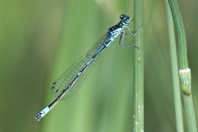Abstract
Coenagrion persicum was described by Heinrich Lohmann in 1993 on the basis of a single male and two larvae captured in 1937 by E.W. Kaiser in Lorestãn Province (W-Iran). In June 2015 two of the authors (TS and DI) rediscovered individual-rich populations of this species in two Iranian provinces (Lorestãn and Esfahãn). We could confirm the structural differences of the male appendages between C. persicum and C. pulchellum based on a larger number of specimens than in the original description. The structural differences from C. pulchellum in females and their phenotypic variation pattern is described. Coenagrion persicum and C. pulchellum are also genetically distinct regarding two nDNA gene fragments: arginine methyltransferase (PRMT) and phosphoglucose isomerase (PGI). In contrast with C. pulchellum, C. persicum prefers small springs and running waters with rich herbal vegetation. Our faunistic data indicate that the species is present in the mountains between 1800 m and 2300 m a.s.l.. The species seems to be restricted to W-Iran, where it co-occurs with other rheophilic species.
References
Battin, T. (1993) Revision of the puella group of the genus Coenagion Kirby, 1890 (Odonata, Zygoptera), with emphasis on morphologies contributing to reproduction isolation. Hydrobiologia, 262, 13 ̶ 29.
Boudot, J.-P. & Kalkman, V.J. (2014) Chapter 5. Odonata (dragonflies and damselflies). In: Smith, K.G., Barrios, V., Darwall, W.R.T. & Numa, C. (Eds.), The status and distribution of freshwater biodiversity in the Eastern Mediterranean. IUCN, Cambridge, pp. 55 ̶ 67.
Boudot, J.-P. & Kalkman, V.J. (Eds.) (2015) Atlas of the European dragonflies and damselflies. KNNV publishing, the Netherlands, pp. 1–381.
Darriba, D., Taboada, G.L., Doallo, R. & Posada, D. (2012) "jModelTest 2: more models, new heuristics and parallel computing". Nature Methods, 9 (8), 772.
http://dx.doi.org/10.1038/nmeth.2109Dijkstra, K.-D.B. (2006) Coenagrion. In: Dijkstra, K.-D.B. & Lewington, R. (Eds.), Field guide to the dragonflies of Britain and Europe. British Wildlife Publishing, Gillingham, pp. 104 ̶ 118.
Drummond, A. & Rambaut, A. (2007) BEAST: Bayesian evolutionary analysis by sampling trees. BMC Evolutionary Biology, 7, 208 ̶ 214.
http://dx.doi.org/10.1186/1471-2148-7-214Dumont, H.J. & Heidari, H. (1996) On a collection of Spring Odonata from Iran, with the description of Coenagrion australocaspicum n.sp. Bulletin de l’lnstitut Royal des Sciences Naturelles de Belgique, 132, 63 ̶ 78.
Edgar, R.C. (2004) MUSCLE: multiple sequence alignment with high accuracy and high throughput. Nucleic Acids Research, 32 (5), 1792 ̶ 97.
http://dx.doi.org/10.1093/nar/gkh340Ferreira, S., Lorenzo-Carballa, M.O., Torres-Cambas, Y., Cordero-Rivera, A., Thompson, D.J. & Watts, P.C. (2014) New EPIC nuclear DNA sequence markers to improve the resolution of phylogeographic studies of coenagrionids and other odonates. International Journal of Odonatology, 17, 2–3, 135–147.
http://dx.doi.org/10.1080/13887890.2014.950698
Ferreira, S., Boudot, J.-P., El Haissoufi, M., Alves, P.C., Thompson, D.J., Brito, J.C., Watts, P.C. (2016) Genetic distinctiveness of the damselfly Coenagrion puella in North Africa: an overlooked and endangered taxon. Conservation Genetics. [Published online]
http://dx.doi.org/10.1007/s10592-016-0826-5
Guindon, S., Dufayard, J.F., Lefort, V., Anisimova, M., Hordijk, W. & Gascuel, O. (2010) New Algorithms and Methods to Estimate Maximum-Likelihood Phylogenies: Assessing the Performance of PhyML 3.0. Systematic Biology, 59 (3), 307–321.
http://dx.doi.org/10.1093/sysbio/syq010IUCN (2015) The IUCN Red List of Threatened Species, 2015.4. International Union for Conservation of Nature and Natural Resources. Available from: http://www.iucnredlist.org/ (accessed 28 October 2015)
Kalkman, V.J., van Pelt, G.J., Dumont, H.J., Yu Haritov, A. & Tailly, M. (2004) Critical species of Odonata in Turkey, Iran and the Caucasus. International Journal of Odonatology, 7, 325 ̶ 339.
http://dx.doi.org/10.1080/13887890.2004.9748220Kalkman, V.J. (2006a) Key to the dragonflies of Turkey, including species known from Greece, Bulgaria, Lebanon, Syria, the Trans-Caucasus and Iran. Brachytron, 10, 3 ̶ 82.
Kalkman, V.J. (2006b) Coenagrion persicum. The IUCN Red List of Threatened Species 2006:e.T59703A11979748. Available from: http://dx.doi.org/10.2305/IUCN.UK.2006.RLTS.T59703A11979748.en (accesed 6 October 2015)
Lohmann, H. (1993) Coenagrion vanbrinkae spec. nov. and C. persicum spec. nov. aus Vorderasien (Zygoptera: Coenagrion). Odonatologica, 22, 203–211.
Ronquist, F. & Huelsenbeck, J.P. (2003) MRBAYES 3: Bayesian phylogenetic inference under mixed models. Bioinformatics, 19, 1572–1574.
http://dx.doi.org/10.1093/bioinformatics/btg180
Sambrook, J., Fritsch, E.F. & Maniatis, T. (1989). Molecular Cloning: A Laboratory Manual. Cold Spring Harbor Laboratory Press, Cold Spring Harbor, NY.
Schneider, T. & Dumont, H.J. (2015) Odonata records from southern Iran. Notulae Odonatologicae, 8, 137–146.
Schneider, T. & Ikemeyer, D. (2016) Notes on Odonata species in South-West-Iran including Platycnemis kervillei (Martin 1909) as a new species for Iran. Entomologische Zeitschrift, 126, 3–8.
Skvortsov, V.E. & Snegovaya, N.Y. (2015) A second addition to the Odonata fauna of Azerbaijan. International Dragonfly Fund Report, 87, 1–38.
Tamura, K., Stecher, G., Peterson, D., Filipski, A. & Kumar, S. (2013) MEGA6: Molecular Evolutionary Genetics Analysis version 6.0. Molecular Biology and Evolution, 30, 2725–2729.
http://dx.doi.org/10.1093/molbev/mst197

